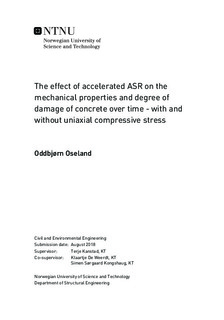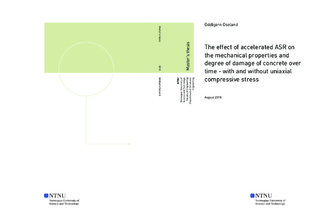| dc.description.abstract | The aim of this master thesis is to investigate the effect on mechanical properties and degree of damage in concrete exposed to accelerated Alkali-silica reaction (ASR) and uniaxial com-pressive stress, and test if the Stiffness Damage Test (SDT) still shows promising result as a tool to predict expansion when samples are restrained. It has previously been shown that uni-axial compressive stress inhibits expansion in the compressed direction. In addition, there has been shown a strong correlation between expansion, degree of damage and change in mechan-ical properties in concrete affected by ASR. A new experimental setup was designed to inves-tigate how external compressive stress affects the development of mechanical properties and degree of damage in concrete exposed to accelerated ASR.
18 prisms were cast and placed under different storage conditions with and without uniaxial compressive stress. Cylinders were drilled out parallel and perpendicular to the load direction at different times to study the effect of the restraints. The degree of damage and change in mechanical properties were investigated performing SDT followed by standard compressive strength tests on the cylinders. Elastic modulus, compressive strength and 3 different damage indices; Stiffness damage index (SDI), Plastic deformation index (PDI) and Non-linearity index (NLI), were calculated from the SDT.
The indices showed a strong logarithmic correlation with increasing level of expansion and the elastic modulus reduc-tion showed a strong linear correlation with increasing expansion. The restrained prisms exposed to accelerated ASR showed lower level of expansion in restrained direction and similar expansion as the free prisms in unrestrained direc-tion. Free ASR affected prisms showed a small reduction in compressive strength compared to the reference prism. However, when looking at the restrained prisms the result was small and vague.
All output parameters except compressive strength points to a lower degree of damage in the restrained prisms. The compressive strength showed weak correlation with expansion and seems to be a poor parameter to use when as-sessing ASR affected concrete. The damage indi-ces, SDI and PDI, showed promising result as tools to assess ASR damaged concrete struc-tures and potentially predict ASR expansion. The NLI showed weak correlation at low expan-sion level, render it less promising. For SDT to be a valid tool to predict expansion, different concrete recipes need to be tested and a thorough description of the test and calculation method needs to be defined. | |

